Signs of spinal stenosis can vary but often include back pain, numbness or weakness in the limbs, or pain that stretches downward into the legs or feet. These symptoms stem from a narrowing in the spaces inside your spine, which can pressurize the many nerves that run along this crucial structure.
Although there is no cure, spinal stenosis is treatable—if you suspect you have this condition, schedule an appointment with your doctor. Additionally, a well-chosen mattress may help alleviate symptoms of spinal stenosis and clear the way to a good night’s rest.
Interested in learning more? I’ve selected a lineup of the best mattresses for spinal stenosis below.
Best Mattresses for Spinal Stenosis
- Helix Midnight – Editor’s Pick
- Nolah Signature – Best Mattress for Side Sleepers with Spinal Stenosis
- The WinkBed – Best Hybrid Mattress for Spinal Stenosis
- Saatva Rx – Best Mattress for Back Pain and Spinal Stenosis
- Bear Original – Best Memory Foam Mattress for Spinal Stenosis
- Brooklyn Bedding Aurora Luxe – Best Cooling Mattress for Spinal Stenosis
- Titan Plus – Best Mattress for Heavy People with Spinal Stenosis
- Plank Firm – Best Firm Mattress for Spinal Stenosis
Mattress for Spinal Stenosis: Making The Right Decision Matters
A good mattress for spinal stenosis should help you feel as comfortable as possible in order to achieve better sleep. Specifically, it should have both solid support and comforting pressure relief. Good support helps keep your spine in a healthy alignment, whereas pressure relieving layers can help cushion your body and curb existing pain.
Compare Beds for Spinal Stenosis
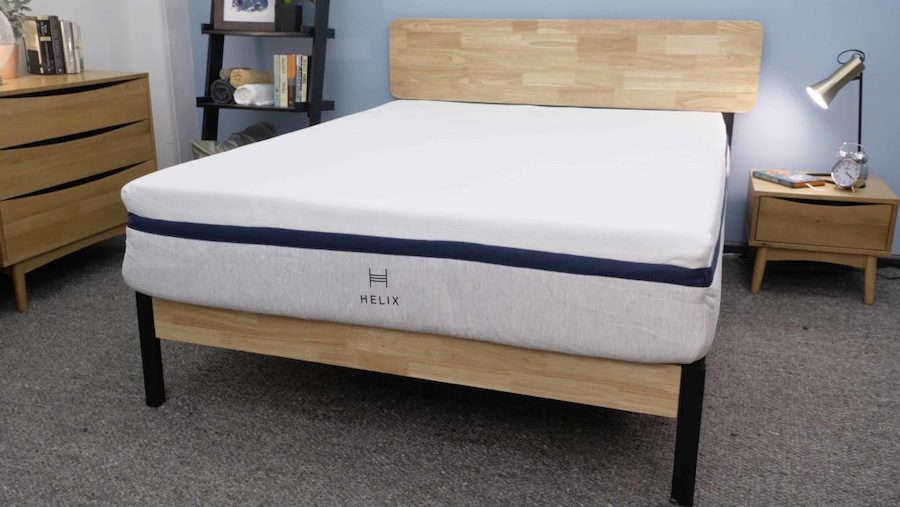
|
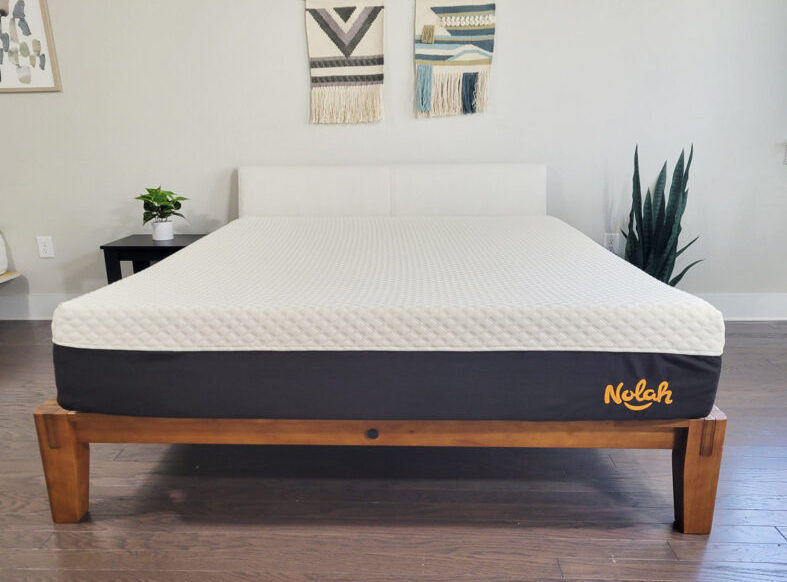
|
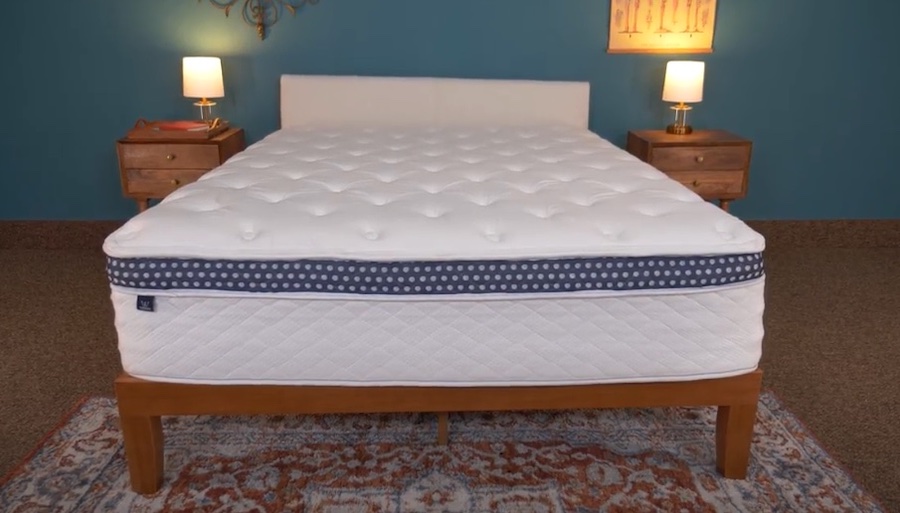
|
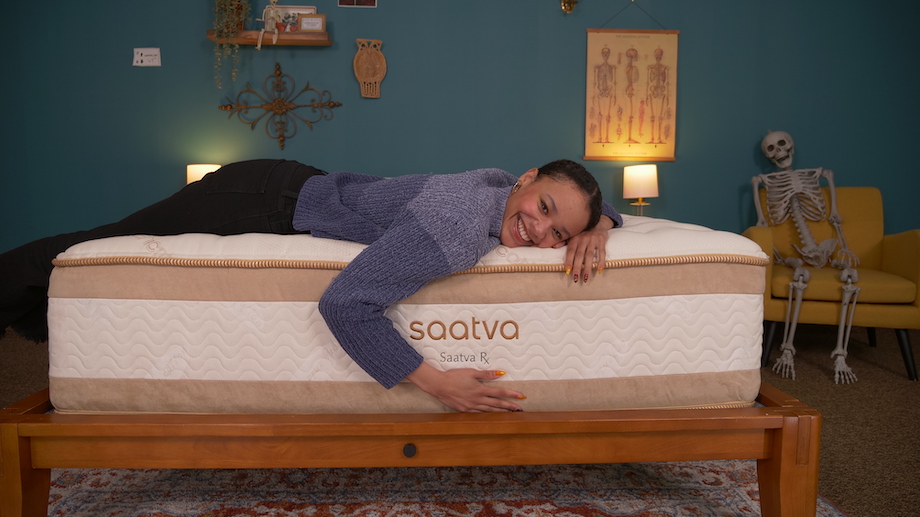
|
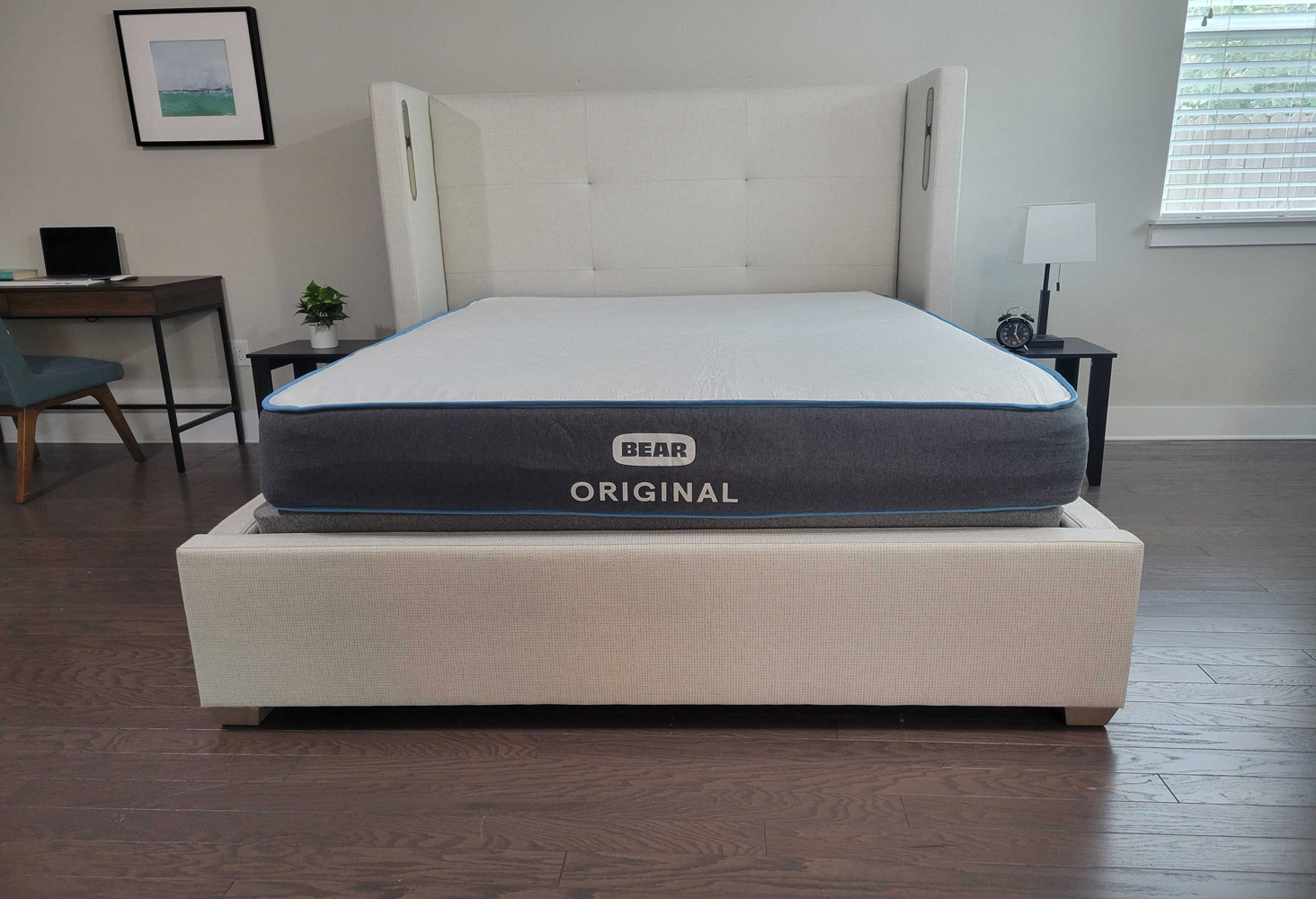
|
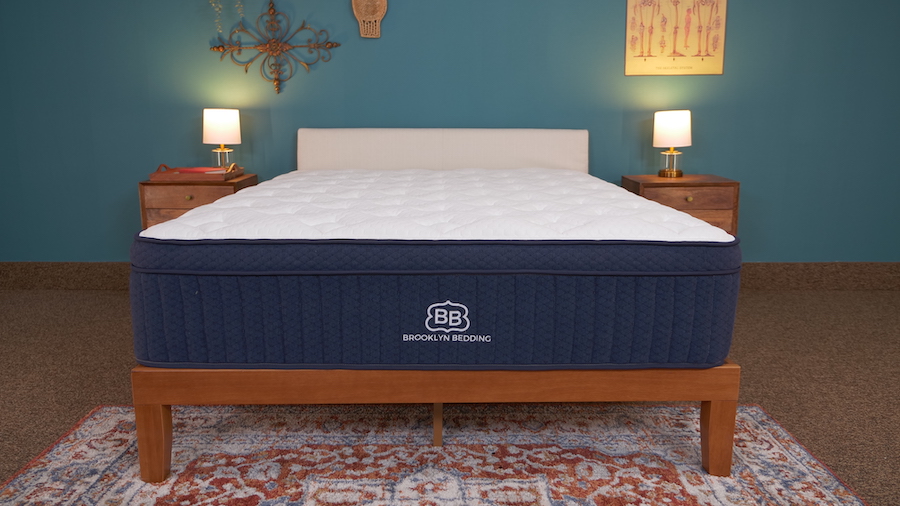
|
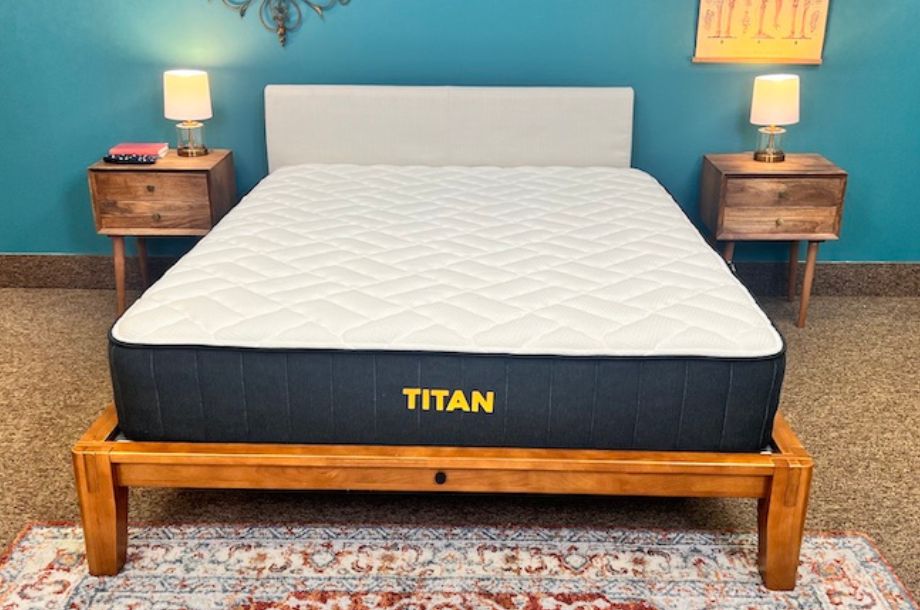
|
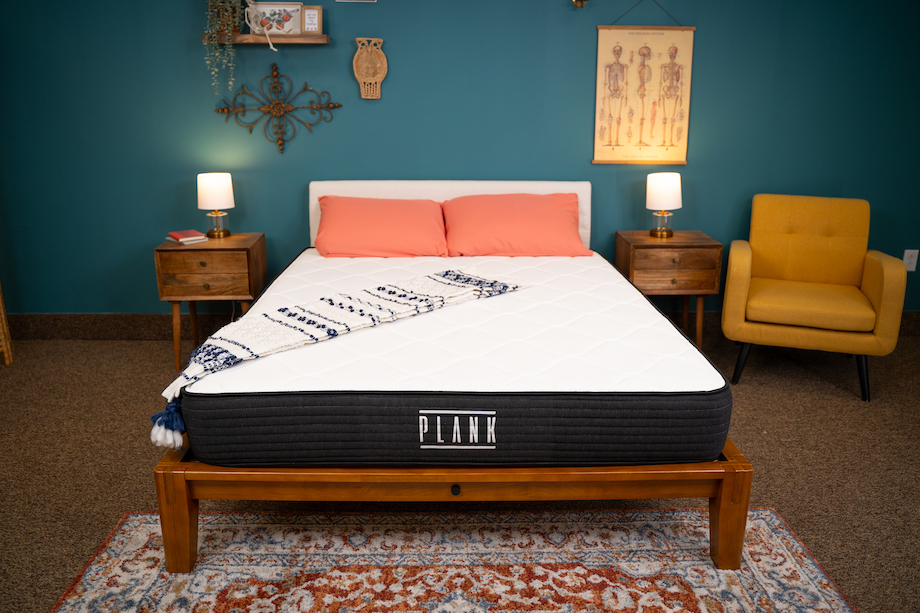
|
|
| Helix Midnight Mattress | Nolah Signature 12″ Mattress | WinkBed Mattress | Saatva Rx Mattress | Bear Original Mattress | Brooklyn Bedding Aurora Luxe Mattress | Titan Plus | Brooklyn Bedding Plank Firm Mattress | |
| Rating | ||||||||
| Firmness | Medium-firm: 6/10 | Medium-firm: 6/10 | Multiple firmness options | Medium-firm: 6/10 | Firm: 7/10 | Multiple firmness options | Firm: 8/10 | Multiple firmness options |
| Material | Hybrid | Foam | Hybrid | Hybrid | Foam | Hybrid | Hybrid | Foam |
| Cooling | — | — | — | — | — | |||
| Warranty | 10-year warranty | Lifetime warranty | Lifetime warranty | Lifetime warranty | Lifetime warranty | 10-year warranty | 10-year warranty | 10-year warranty |
| Shipping | Free shipping | Free shipping | Free shipping | Free white glove delivery | Free shipping | Free shipping | Free shipping | Free shipping |
| Trial Period | 100 nights | 120 nights | 120 nights | 365 nights | 120 nights | 120 nights | 120 nights | 120 nights |
| Best For | Side Sleepers, Back Sleepers, Couples | Side Sleepers, Back Pain | Side Sleepers, Back Sleepers, Stomach Sleepers, Hot Sleepers, Back Pain, Hip Pain, Seniors | Side Sleepers, Back Sleepers, Stomach Sleepers, Back Pain, Hip Pain, Seniors | Side Sleepers, Back Sleepers, Hot Sleepers, Hip Pain | Side Sleepers, Hot Sleepers, Back Pain | Back Sleepers, Stomach Sleepers, Back Pain, Hip Pain, Seniors | Stomach Sleepers, Back Pain, Seniors |
Sleep Advisor’s Testing Methodology
At Sleep Advisor, our mattress reviews are based on findings from in-person tests that allow us to have a genuine understanding of how the mattress feels and performs.
For this roundup, I focused on mattress qualities that are specifically important to those with spinal stenosis, such as firmness, pressure relief, motion isolation, and edge support. I also incorporated the expertise of our Chief Medical Advisor, Dr. Raj Dasgupta.
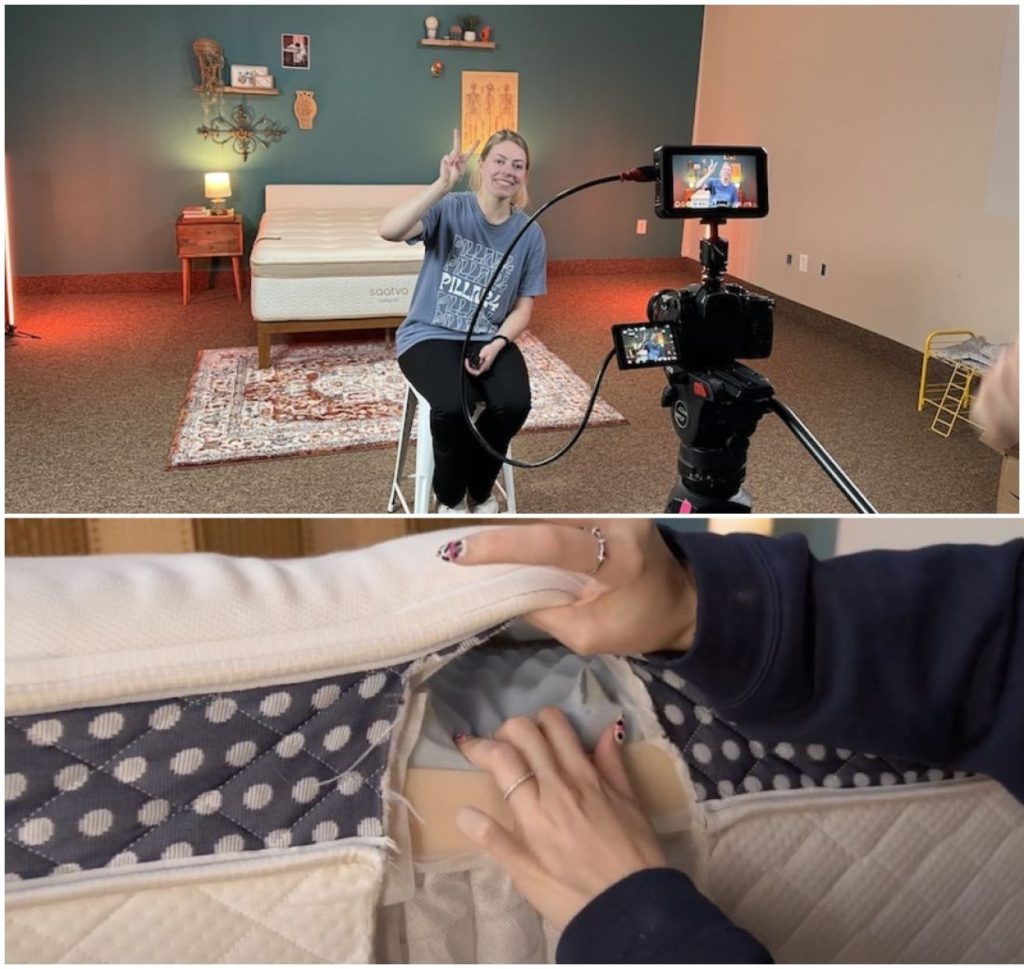
Advice from a Medical Expert
We reached out to Dr. Raj Dasgupta, who has over 20 years of experience in the medical field, to see his thoughts on what key qualities people with spinal stenosis should look for in a mattress.
“To help alleviate some of the symptoms of spinal stenosis, choose a medium-firm to firm mattress that gives plenty of support for your lower back. It should be made of contouring materials (such as memory foam or latex) and relieve pressure points. If it’s adjustable, that could be a bonus, and make sure the mattress is durable and will last.”
Top Beds for Spinal Stenosis
Helix Midnight – Editor’s Pick

Helix Midnight Mattress

Product Details
Our Recommendation
Financing Options
Financing options are available for this mattress.
Why the Helix Midnight Earned the Best Mattress for Spinal Stenosis Overall
The Helix Midnight was designed for side sleepers, but it has a plethora of features that make it a great choice overall for folks with spinal stenosis. It should balance pressure relief and support, and the medium-firm feel should accommodate most sleepers.
The Midnight features memory foam and poly foam layers that deliver a mix of cushioning and contouring, bolstered by sturdy coils underneath. Individuals who toss and turn at night should also appreciate the responsive middle layers of the mattress. So, it’s easy to see why we gave it the top spot.
What’s the Helix Midnight Made Of?
The Helix Midnight has five layers and is 11.5 inches thick. All foams used in the construction of this bed are also CertiPUR-US® Certified.
The standard cover that comes with the bed is soft and stretchy, but for an extra fee, you can upgrade to a GlacioTex™ Cooling Cover. The first layer of the bed is made up of a memory foam blend that cradles pressure points.
Next up are two layers of responsive foam to provide contouring and support. The second of these layers also helps to transition into the coil unit, which consists of up to 1,000 individually wrapped coils that aid in isolating motion.
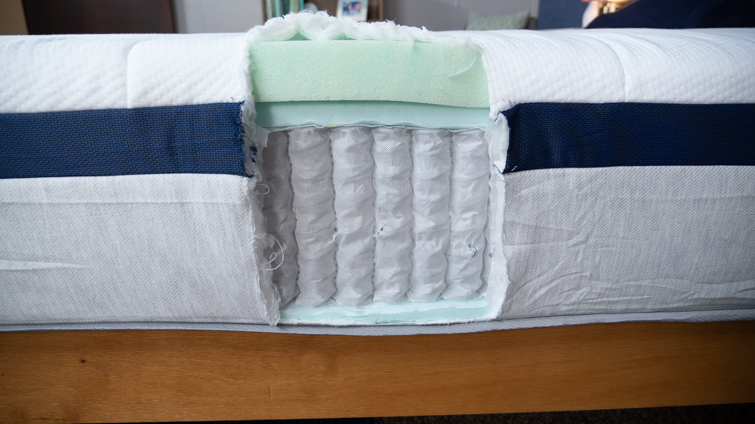
These coils also reinforce the longer edges of the mattress to combat sagging edges. Finally, the dense foam bottom layer of the mattress stabilizes the bed.
Our Take: The Helix Midnight offers a nice balance of pressure relief around the shoulders and hips and support to prevent any of these sections from sinking too deeply. This should create a soft enough surface without compromising alignment.
Customer Reviews of the Helix Midnight
The Helix Midnight rates 4.5 stars out of 5 on Helix’s website. The main negative is that reviewers tend to find it too soft for their liking and feel as though they’re sinking. But overall, users say they’re getting a great night’s sleep and some pain relief.
Interested in more details? See our Helix Midnight mattress review here, or check out our best mattresses of 2024.
Nolah Signature – Best Mattress for Side Sleepers with Spinal Stenosis

Nolah Signature 12″ Mattress

Product Details
Our Recommendation
Financing Options
Financing options are available for this mattress.
Why the Nolah Signature Earned Best Mattress for Side Sleepers with Spinal Stenosis
Side sleepers with spinal stenosis may benefit from a softer bed that alleviates pressure build-up around problem areas, like the hips and shoulders. The all-foam construction of the Nolah Signature has pressure-relieving properties and contouring foams that do just that.
In particular, this bed features Nolah’s proprietary AirFoam™ in two layers, which work together to relieve pressure throughout the back.
What’s the Nolah Signature Made Of?
The Nolah Signature is 12 inches thick with five layers. The cover is designed to wick away moisture for cooler sleep.
The first layer of AirFoam™ seeks to provide cushioning. Then comes another layer of foam dubbed “Active Response Foam,” designed to be breathable and, you got it, responsive. A subsequent layer of AirFoam™ adds even more pressure relief. Finally, a 7-inch slab of high-density foam acts as the stable foundation for the bed.
Our Take: The Nolah Signature is an all-foam mattress designed for pressure relief, so it should be a good match for people with spinal stenosis. Plus, the base layer is highly supportive, so alignment shouldn’t be an issue.
Customer Reviews of the Nolah Signature
The Nolah Signature gets a 4.8 out of 5 stars on Nolah’s website. One potential drawback of the Nolah Signature mattress is its limited firmness options, but it excels in providing exceptional pressure relief and a cooling sleep experience.
Want to see more? Visit our in-depth Nolah Signature mattress review or our picks for the best mattress for side sleepers.
The WinkBed – Best Hybrid Mattress for Spinal Stenosis

WinkBed Mattress

Product Details
Our Recommendation
Financing Options
Financing options are available for this mattress.
Why the WinkBed Earned Best Hybrid Mattress for Spinal Stenosis
The WinkBed, with its multiple firmness options, should offer an excellent solution for anyone with spinal stenosis seeking a hybrid mattress. The WinkBed comes in Soft, Luxury Firm, and Firm variants, alongside a Plus model for folks over 200 pounds.
The coils in this model are super springy but also sturdy. They were tested for durability, so they should last you a long time. The foams on top, especially in the softer model, should offer some pressure relief as well to reduce pain buildup in crucial areas.
What’s the WinkBed Made Of?
The WinkBed stands 13.5 inches tall. It has a Tencel™ cover that’s breathable, eco-friendly, and OEKO-TEX® certified for safety.
The Euro top of this bed provides a comfortable but supportive sleep surface outfitted with gel-infused foam for added cooling. Underneath are additional foam layers, including the LumbarLayer™ that targets and lifts the lower back.
The coil layer is made up of individually pocketed steel coils and surrounded by an Extra-Edge™ supportive perimeter.
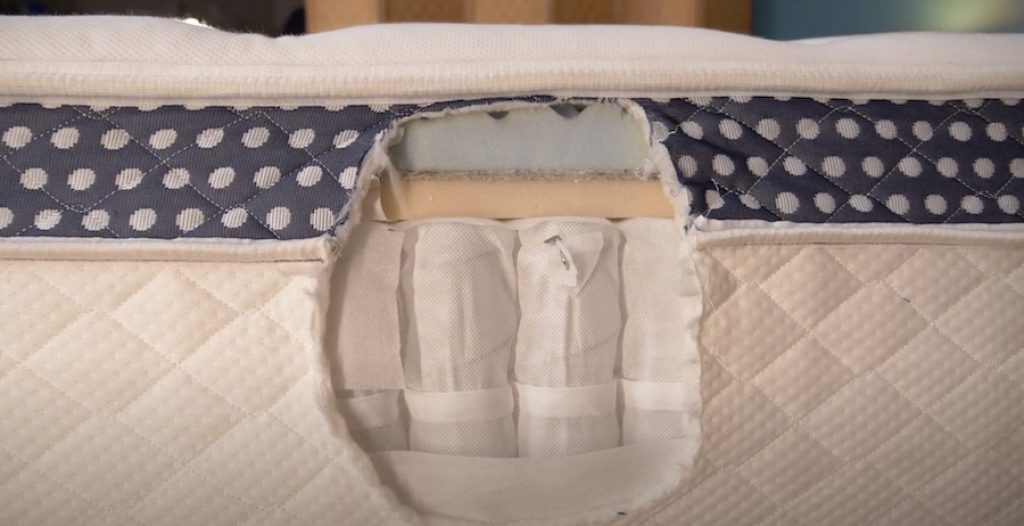
Our Take: This mattress’s foam layering should do a good job of relieving pressure and allowing more comfortable sleep for people with spinal stenosis. Plus, it’s available in multiple firmnesses for more tailored comfort.
Customer Reviews of the Winkbed Mattress
On the WinkBeds site, the WinkBed earns a 4.8 out of 5 stars. One drawback of the WinkBed mattress is that it might be too expensive for budget-conscious shoppers, but overall it offers excellent durability and customizable firmness options.
Want more info? Check out our WinkBed mattress review or see other options on our best hybrid mattresses page.
Saatva Rx – Best Mattress for Back Pain and Spinal Stenosis

Saatva Rx Mattress

Product Details
Our Recommendation
Financing Options
Financing options are available for this mattress.
Why the Saatva Rx Earned Best Mattress for Back Pain and Spinal Stenosis
When treating chronic pain, the Saatva Rx is one of the best. Designed specifically for folks with medical conditions that cause severe back and joint pain, it boasts many features that provide enhanced support and comfort.
Multiple coil units, a therapeutic support coil, and dense foam layers all contribute to the bed’s unique pain-relieving capability. This can make it one of the best options if you have back pain from spinal stenosis.
What’s the Saatva Rx Made Of?
The Saatva Rx is 15 inches thick. Its cover is made with breathable organic cotton for cooler sleep. It’s treated to resist microbial growth and has quilting in the center for lower back support. Underneath is a gel memory foam lumbar crown that bolsters this support while also providing pressure relief.
Then, two layers of dense foam surround a layer of miniature coils. These 1-inch coils adapt quickly to contour to your body.
The Therapeutic Support Core of the mattress consists of pocketed coils with modular foam modules atop each. This open-celled foam assists in airflow as well as motion isolation since the coils react to keep you lifted without exacerbating pain.
Finally, the mattress sits on top of an eco-friendly base to keep everything stable.
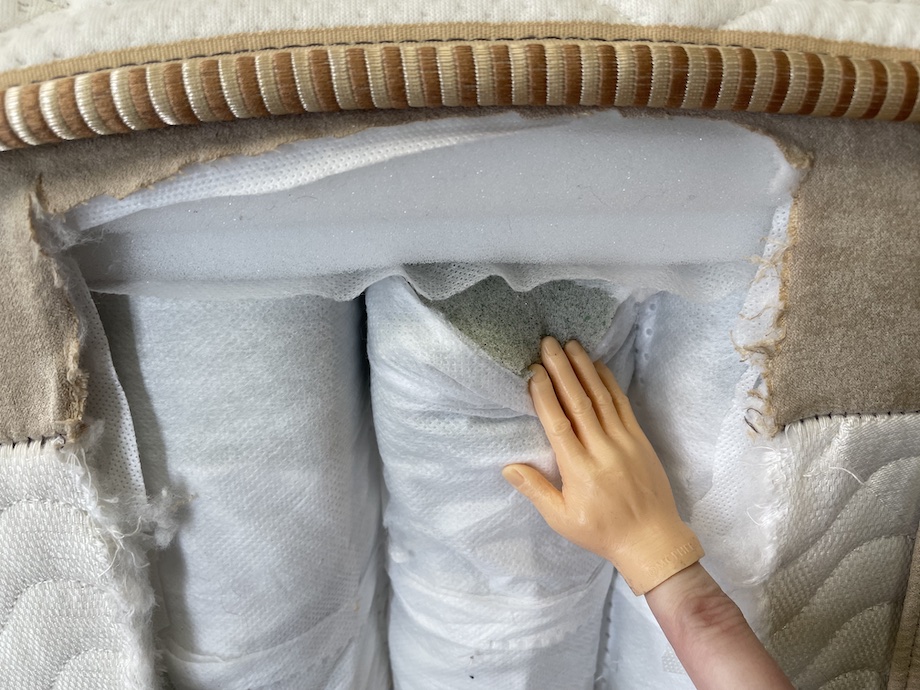
Our Take: “The Rx is going to have a gold-star standard because of the pressure relief. That got a perfect score as well. We didn’t detect any pressure buildup during testing, so this is good news if you have hip, shoulder, or back pain.” – Loren Bullock, Sleep Advisor Mattress Tester
Customer Reviews of the Saatva Rx
Customers on Saatva’s website have awarded the Saatva Rx 4.8 out of 5 stars on average. Multiple testimonies praise the bed for helping with chronic back and neck pain, with only a few mentioning drawbacks such as lackluster edges.
Looking to learn more? Check out our Saatva Rx mattress review or our picks for the best mattresses for sleepers with back pain.
Bear Original – Best Memory Foam Mattress for Spinal Stenosis

Bear Original Mattress

Product Details
Our Recommendation
Financing Options
Financing options are available for this mattress.
Why the Bear Original Earned the Best Memory Foam Mattress for Spinal Stenosis
Memory foam is one of the best options for pressure relief, meaning it can cradle any painful areas exacerbated by spinal stenosis. However, spinal alignment is also important for this condition. The Bear Original bed should deliver on both.
Its all-foam construction features a cooling gel memory foam and a responsive transition foam. These two foams foster a healthy balance of pressure relief and support for the back and other sensitive areas, including the hips, shoulders, and knees. The firmness of the mattress also contributes to its ability to keep your spine aloft and in the proper position.
What’s the Bear Original Made Of?
The Bear Original has three layers and a 10-inch thickness.
The cover that comes with the bed is made with Tencel™, a breathable textile that helps the bed keep cool. But for an extra fee, you can upgrade to their Celliant®-infused cover. Celliant® is a material that allegedly converts body heat into infrared light, thereby aiding in muscle recovery.
The bed’s three layers are made of three different kinds of foam. The first is memory foam infused with cooling gel, meant to cool you down and keep your spine properly aligned.
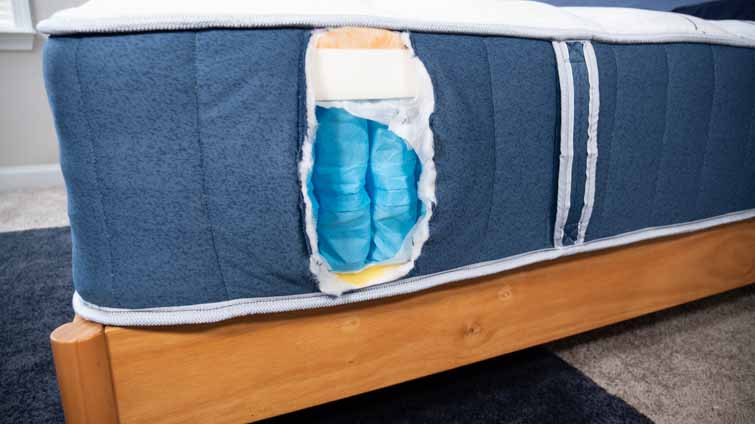
The second is what Bear calls dynamic foam, which targets pressure points in need of lift with its supportive capability. Finally, a layer of high-density foam gives the bed its reliable durability.
Our Take: This bed is firm enough to keep your body properly aligned, while the dynamic foam targets pressure points, all of which are crucial for people with spinal stenosis.
Customer Reviews of the Bear Original
According to Bear’s website, the Bear Original scores about 4.5 out of 5 stars. Customers appreciate the Bear Original mattress for its excellent pressure relief but have reported that its edge support may be lacking, which could affect those who use the full mattress surface.
Want to read more? Check out our Bear Original mattress review or explore our picks for the best memory foam mattresses.
Brooklyn Bedding Aurora Luxe – Best Cooling Mattress for Spinal Stenosis

Brooklyn Bedding Aurora Luxe Mattress

Product Details
Our Recommendation
Financing Options
Financing options are available for this mattress.
Why the Brooklyn Bedding Aurora Luxe Earned Best Cooling Mattress for Spinal Stenosis
People with spinal stenosis who want to stay cool through the night might consider the Brooklyn Bedding Aurora Luxe, a hybrid model. Brooklyn Bedding has included GlacioTex™ fibers in this bed, ensuring the best temperature regulation for a good night’s sleep.
The Aurora Luxe’s layers include proprietary CopperFlex™ foam with TitanCool™ phase change material, proprietary TitanFlex™ foam, gel memory foam, and pocketed Ascension® coils, all contributing to a breathable construction.
What’s the Brooklyn Bedding Aurora Luxe Made Of?
Composed of six different layers, the Brooklyn Bedding Aurora Luxe is 13 inches thick. It comes in three firmness options: Soft, Medium, and Firm. The GlacioTex™ cover of the mattress aims to redirect excess heat away from you. Underneath is a 1.5-inch layer of CopperFlex™ foam, a foam treated with a phase change material that contours to your curves, relieves pressure, and regulates temperature.
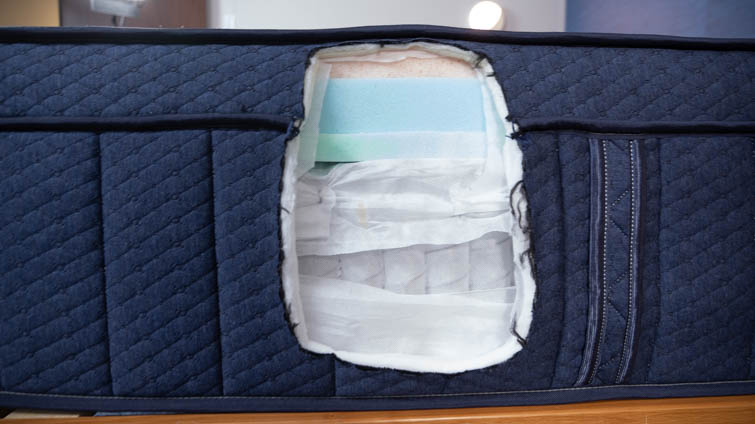
Next is a layer of Supreme Response Comfort Foam that ensures buoyancy. The thickness and feel of this layer are determined by the firmness you choose. The third layer of foam in the Soft and Medium options is Brooklyn’s Gel Swirl Memory Foam, adding an extra cooling layer. In the Firm model, a VariFlex™ transition foam layer lends more support to the bed.
Zoned Ascension® coils make up the spring unit of the bed, each intended to target a specific part of the body for the appropriate amount of lift or pressure relief. Finally, the bed sits atop a high-density foam base to maintain stability.
My Take: The Brooklyn Bedding Aurora Luxe is available in multiple firmnesses, giving folks with spinal stenosis more choices on what they find most comfortable. I also love its zoned support to help relieve tension and pain.
Customer Reviews of the Brooklyn Bedding Aurora Luxe
On Brooklyn Bedding’s site, the Aurora Luxe has a rating of 4.7 out of 5 stars. Customers praise the Brooklyn Bedding Aurora Luxe mattress for its advanced cooling features, but some have mentioned that it is relatively expensive compared to other options.
Want to read more? Check out our Aurora Luxe mattress review or check out our best cooling mattress picks.
Titan Plus – Best Mattress for Heavy People with Spinal Stenosis

Titan Plus

Product Details
Our Recommendation
Financing Options
Financing options are available for this mattress.
Why the Titan Plus Earned Best Mattress for Heavy People with Spinal Stenosis
Individuals who carry more weight may find that certain areas of their body sink too deeply into a bed without enough support. This sinkage creates poor spinal alignment, which can worsen already-existent back pain from spinal stenosis.
The Titan Plus was made to fit plus-size sleepers, so it easily deals with these problems. You should feel comfortable on its supportive surface and achieve enough pressure relief to cushion sensitive areas of your spine.
What’s the Titan Plus Made Of?
The Titan Plus is 11 inches tall. It typically has four layers, but you can also pay extra for a GlacioTex™ Cooling Cover.
The first layer is a 1-inch gel memory foam, which feels cooler than typical foams and is designed to prevent indentations from forming at the surface. Underneath, a 2-inch layer of TitanFlex™ foam molds to your body while relieving pressure buildup in sensitive areas.
The innerspring unit of the mattress is 6 inches thick. The coils within are wrapped to respond individually to your movements. Stronger coils line the perimeter for edge support. Finally, a 2-inch dense foam base rounds out the mattress.
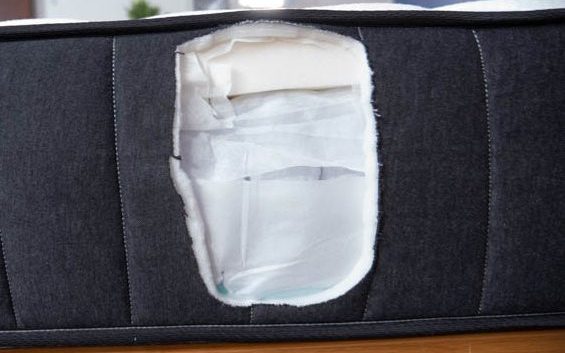
Our Take: “Bottom line: for all plus-size sleepers, there should be plenty of support and pressure relief regardless of your sleeping position.” – Spencer, Sleep Advisor Mattress Tester
What We Liked
- Strong edges – The edges of the Titan Plus are super sturdy, which is great if you like to sleep or sit near the perimeter of your mattress. Our tester Patrick recommended this bed “if you like to spread out.”
- Isolates motion well – Patrick also noticed that despite the bed’s springy surface, it absorbed motion pretty well: “Restless sleepers probably won’t wake up their sleeping partners.”
Potential Drawbacks
- Too firm for some – As the Titan Plus is made for heavyweight sleepers, a lot of people may find it too firm and thus unyielding. If you share the bed with a lightweight sleeper (especially one who prefers to sleep on their side), they may not be able to sink comfortably into this bed.
- Not super cradling – This bed’s firmer, hybrid feel might not work for folks who are looking for the super-sink feeling that memory foam provides. The Titan Plus won’t feel uncomfortable, but it won’t give that “hug” feeling many people prefer from their bed.
Customer Reviews
Users on Titan by Brooklyn Bedding’s site have given the Titan Plus a 4.7 out of 5 stars. There are over 2,500 reviews where most customers find the Titan Plus mattress to offer exceptional durability and support, but some mention that it might be too firm for those who prefer a softer feel.
Want to read more? Visit our full Titan Plus review or check out other mattresses for heavy people.
Plank Firm – Best Firm Mattress for Spinal Stenosis

Brooklyn Bedding Plank Firm Mattress

Product Details
Our Recommendation
Financing Options
Financing options are available for this mattress.
Why the Plank Firm Earned Best Firm Mattress for Spinal Stenosis
Sometimes, an extra-soft surface isn’t the best prescription for comfort. People with spinal stenosis who enjoy a more supportive bed may find their match in the Plank Firm, a particularly buoying mattress that guards against troublesome sinkage.
The Plank Firm was designed to mimic mat-like sleeping surfaces while preserving the height and comfort of a traditional bed. It’s a flippable mattress with a firm side and an ultra-firm side. The ultra-firm side has an even flatter cover than the firm side, whereas the firm side has a loftier cover as well as a layer of comfort foam leading into the bed’s high-density foam core.
What’s the Plank Firm Made Of?
The Plank Firm is a flippable mattress with four layers and an overall height of 9.5 inches.
The ultra-firm side has a quilted top with continuous stitching, meaning there will be absolutely no loft for a truly firm experience. The regular firm side, on the other hand, has tack-and-jump stitching and a 2-inch layer of high-density TitanFlex™ foam to provide some loft and bounce-back.
The core of this mattress is 6 inches thick and is made of high-density foam. For an extra fee, you can have a GlacioTex™ Cooling Cover added to both sides of the mattress.
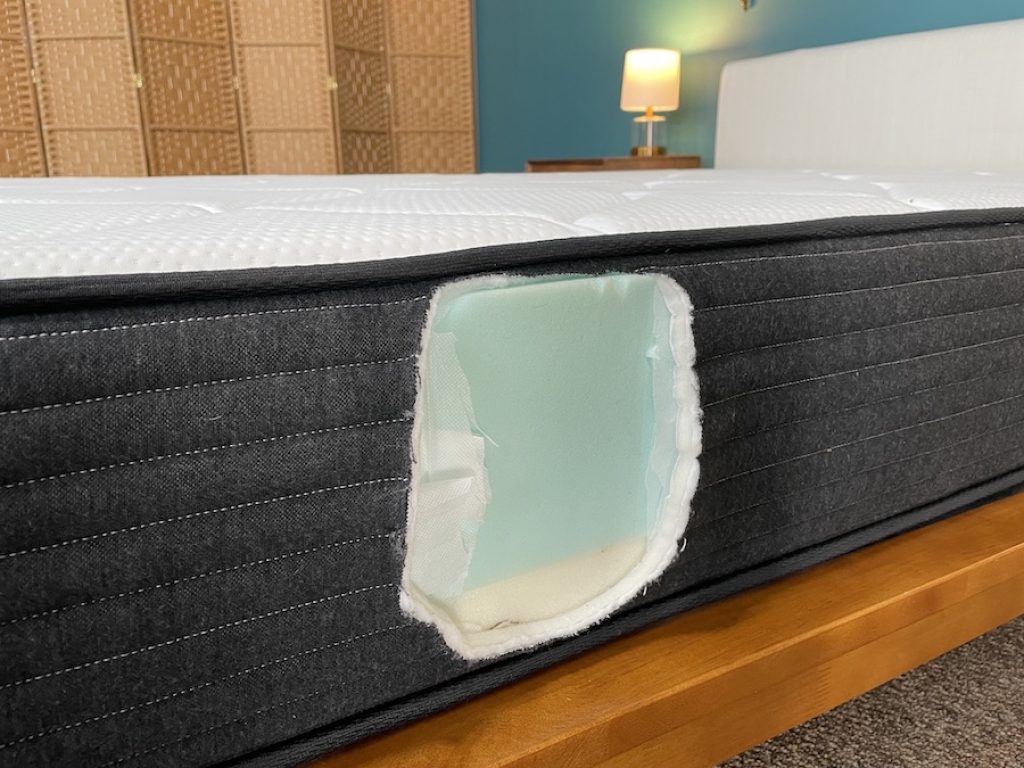
My Take: Since this mattress is so firm, I think it’s excellent for heavier people with spinal stenosis. Plus, it’s flippable, so you can work around finding the side that works best for you.
Customer Reviews of the Plank Firm
On Plank’s website, the Plank Firm gets 4.8 out of 5 stars. Customers appreciate the Brooklyn Bedding Plank Firm mattress for its exceptional firmness, but some have found it to be too rigid for their comfort preferences.
Curious about this bed? Read our full Plank Firm mattress review or peruse our list of the best firm mattresses.
Can a Mattress Help If You Have Spinal Stenosis?
Having the right mattress is a huge step in the right direction for someone with spinal stenosis, as it could help mitigate discomfort by relieving neck and back pain while promoting better spine alignment.
With that in mind, you’ll want to get a bed with the ideal mattress firmness level for your weight and sleeping position for optimal comfort since a bed that’s too soft or too firm could wind up worsening your pain. Check out ourmattress firmness guide to find the firmness that will support you the most and help you get the best night’s sleep.
What to Look for in a Mattress for Spinal Stenosis
Spinal stenosis can put pressure on the spinal cord. Therefore, when looking for a mattress to help ease the discomfort this can cause when you’re sleeping, there are certain factors that you should consider, including the type of bed you get and performance-based features.
What Type of Mattress is Best for Spinal Stenosis?
Memory Foam
The contouring nature of memory foam helps disritubte your weight evenly for exceptiontional pressure relief. Memory foam’s excellent pressure relieving capabilities can make it worthwhile for those with spinal stenosis, though make sure the bed’s supportive layers hold you up well too.
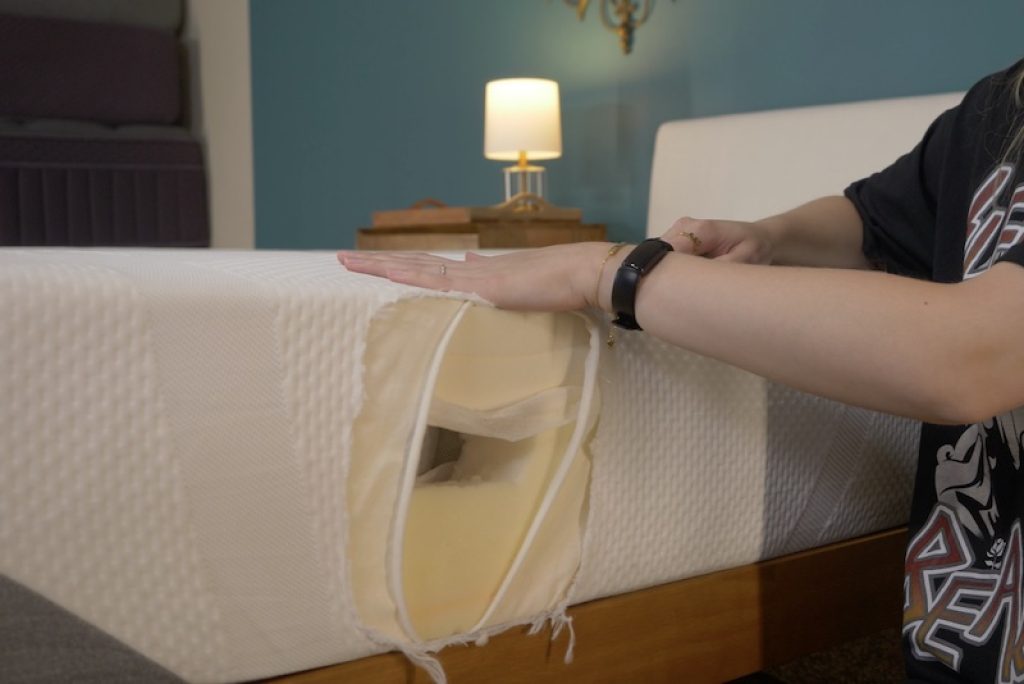
Check Out Our Guide: Best Memory Foam Mattresses
Hybrid
A hybrid mattress can be a good option for people with spinal stenosis because it offers a balance of cushioning and support through a combination of both coils and memory foam or latex comfort layers on top. The foam helps with pressure relief, while the coils deliver support to the spine.
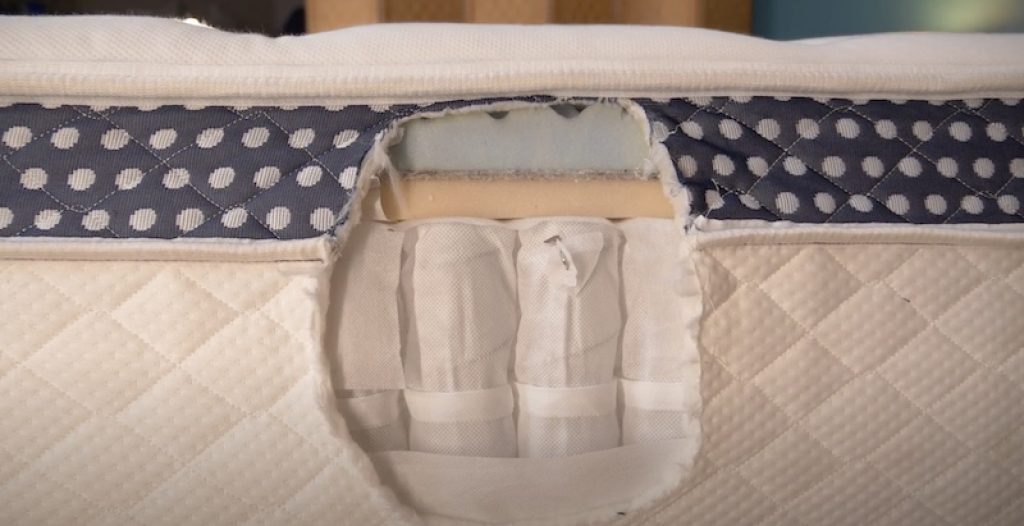
Innerspring
The coil unit in innerspring beds can provide plenty of bounce for easy repositiong and support for the spine. However, traditional innerspring models often just have a thin comfort layer that leaves you practically little to no pressure relief. For this reason, I wouldn’t consider innerspring beds the best option for spinal stenosis.
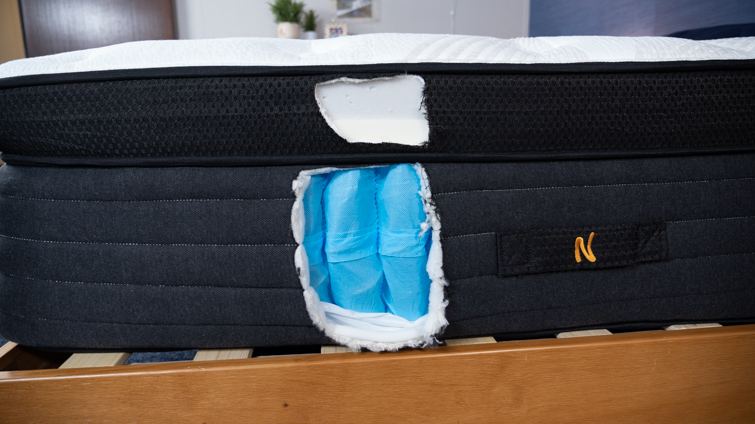
Latex
Latex beds can also be a great choice for those with spinal stenosis, particularly combination sleepers. Along with exceptionally durability, these mattresses are often more responsive to help make it easier for you to change positions, and latex can still be adept at relieving pressure. As with memory foam, just make sure you get plenty of supportive from the bottom layers.
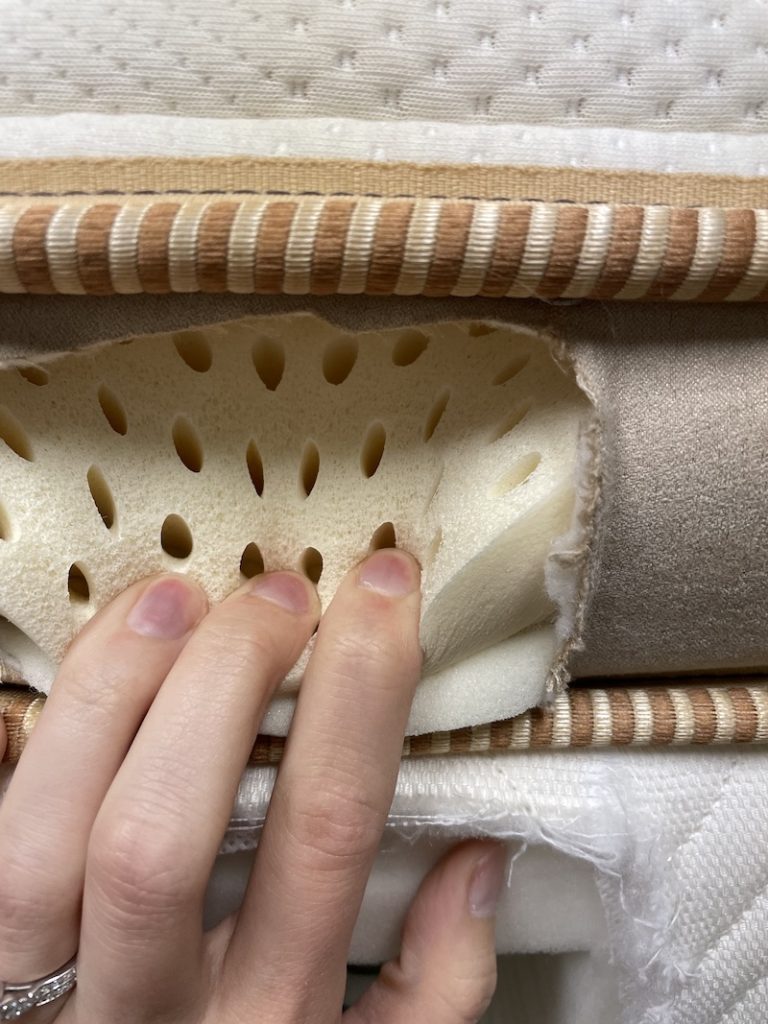
Find Out More: Best Latex Mattresses
Other Considerations When Buying a Mattress for Spinal Stenosis
Back Support and Spinal Alignment
Mattresses with exemplary back support and spinal alignment capabilities may help relieve the pain caused by the pressure that spinal stenosis can cause. Good back support allows the spine to remain in a neutral alignment, reducing your risk of exacerbating back discomfort. For those who carry more weight, the coils in hybrid mattresses can offer more advanced support than all-foam models.
“If your mattress is too soft and doesn’t give your spine enough support, it can make your spinal stenosis symptoms worse. Look for a mattress that’s at least medium-firm, is supportive, and relieves any pressure points that are bothering you.”
Dr. Raj Dasgupta
Firmness
You’ll want to get a bed with the ideal mattress firmness level for your weight and sleeping position for optimal comfort since a bed that’s too soft or too firm could wind up worsening your pain. Check out our mattress firmness guide to find the firmness that will support you the most and help you get the best night’s sleep.
Adjustable Base Compatibility
Elevating your head and/or feet with an adjustable bed could help eliminate some of the pain associated with spinal stenosis by minimizing spinal pressure through the zero-gravity position. A variety of beds, including memory foam and hybrids, are compatible with adjustable bases.
Need more info? Browse our picks for the best adjustable bed frames.
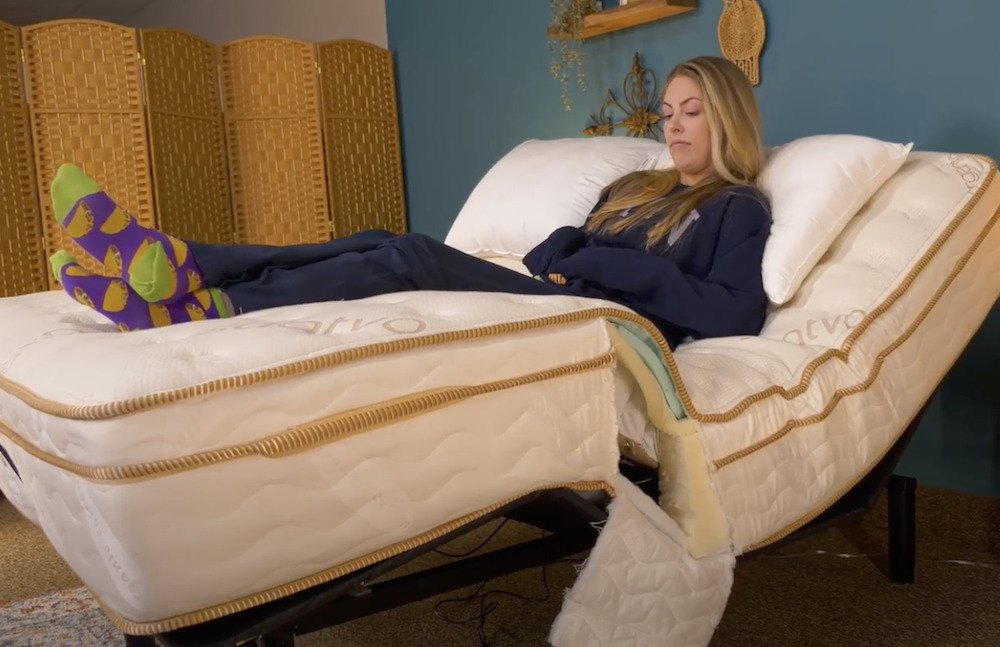
Pressure Relief
Finding a mattress that offers excellent pressure relief is likely near the top of your list when shopping for a bed for spinal stenosis. Considering that spinal stenosis puts pressure on the back and is often concentrated in the lower back1, finding a mattress that provides pressure relief and spinal support will probably be a high priority.
We test for pressure relief using a pressure map. If the map readings turn out green and blue, it indicates the mattress offers good pressure relief, while yellow and red readings indicate there’s buildup.
I think many sleepers with spinal stenosis should find comfort in slow-moving and contouring beds made from memory foam. However, softer latex mattresses can also do a good job of relieving pressure but with more responsiveness to foster easier repositioning. This could also be helpful for those with limited mobility due to spinal stenosis.
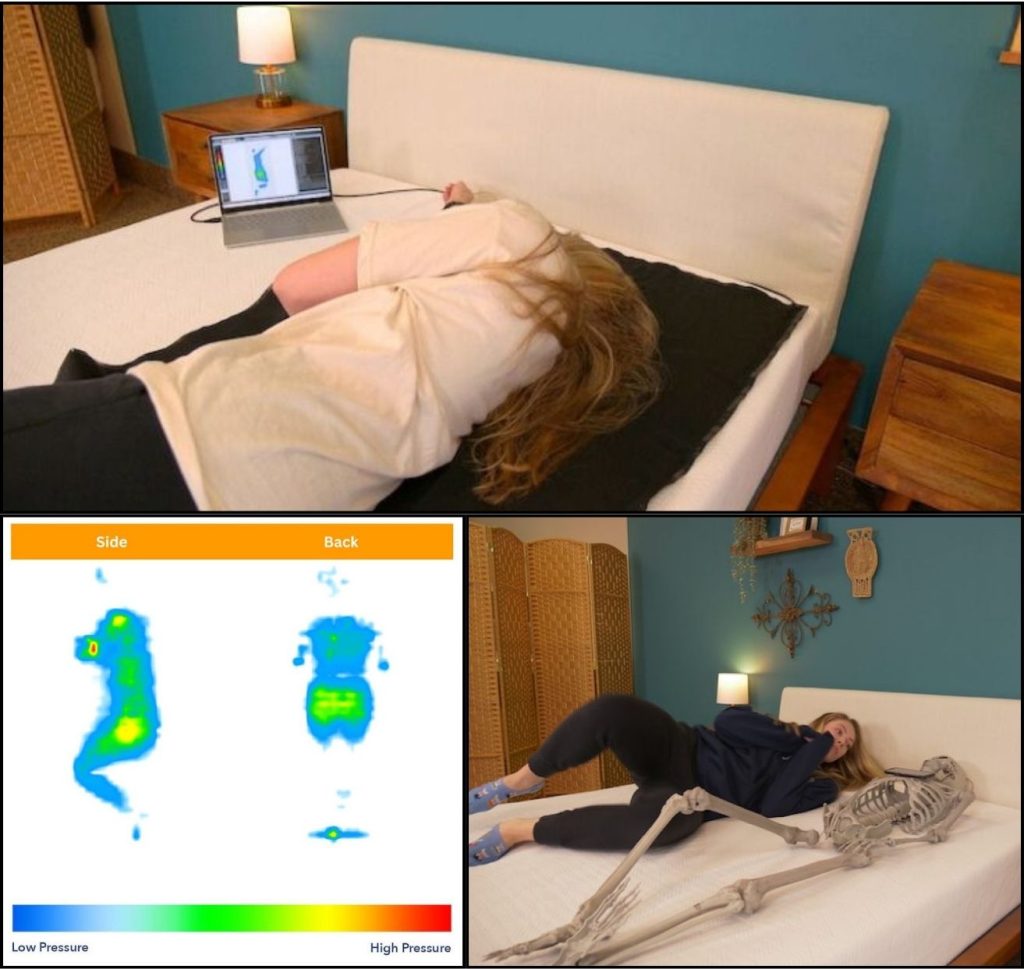
Explore our picks for the Best Mattresses for Pressure Relief.
Edge Support
Although support that extends to the perimeter of the bed is important for couples and those who enjoy utilizing the whole bed when sleeping, those with spinal stenosis could benefit from strong edges that make it easier to get in and out of bed. If the edge of your mattress sags down instead of providing a solid base, it can make it difficult and even painful to lower yourself into bed or push yourself up.
I test each mattress by sitting and lying at the edge for a minute, which helps me evaluate just how supportive this area is.
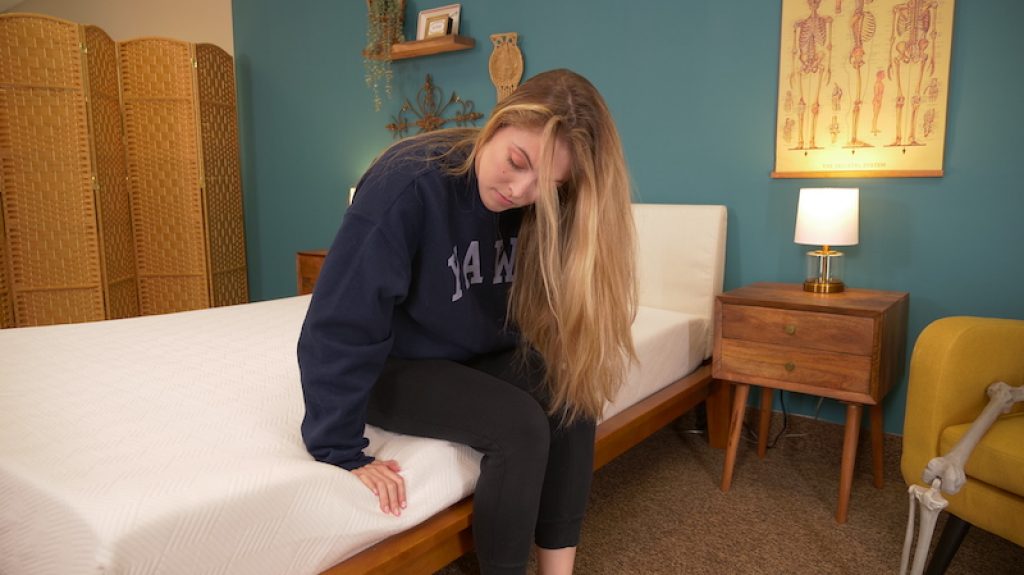
Sleeping Position
Although your preferred sleeping position may feel the most natural and comfortable to you, some postures may do more harm when dealing with spinal stenosis. Sleeping on your back2 can put the least amount of pressure on your spine, so this position is worth trying if you’re not already a back sleeper. Side sleeping3 could also help, but stomach sleeping should be avoided since you’re more susceptible to the lower back curving uncomfortably.
For back sleeping, I recommend supportive mattresses with a medium-firm feel that balances both pressure relief and support.
Weight/Body Type of Sleepers
Your weight can be a major factor when it comes to shopping for a mattress for spinal stenosis. Lightweight sleepers are likely going to find more relief on a softer, plusher mattress, whereas a heavier person would need a firmer, more supportive mattress to keep them from pushing through the comfort layers too quickly and compromising their body alignment.
When I I test mattresses, I’m coming at the experience as an average-weight sleeper. In addition to my own feedback, Loren Bullock provides her thoughts as our lightweight tester and Spencer Bland is our heavyweight tester. This gives us a genuine understanding of how each bed performs for different body types.
Explore our best mattresses for heavy people.
Cooling
Being hot and sweaty can make your back trouble worse for many reasons, one of which is dehydration. When you’re not properly hydrated, you lose fluid in your joints4, which could exacerbate your existing symptoms.
If you’re after memory foam (that tends to get hot), I suggest you look for specific cooling features such as gel or copper infusions or an open-cell structure that allows more airflow. A cool-to-the-touch cover might also be a good idea.
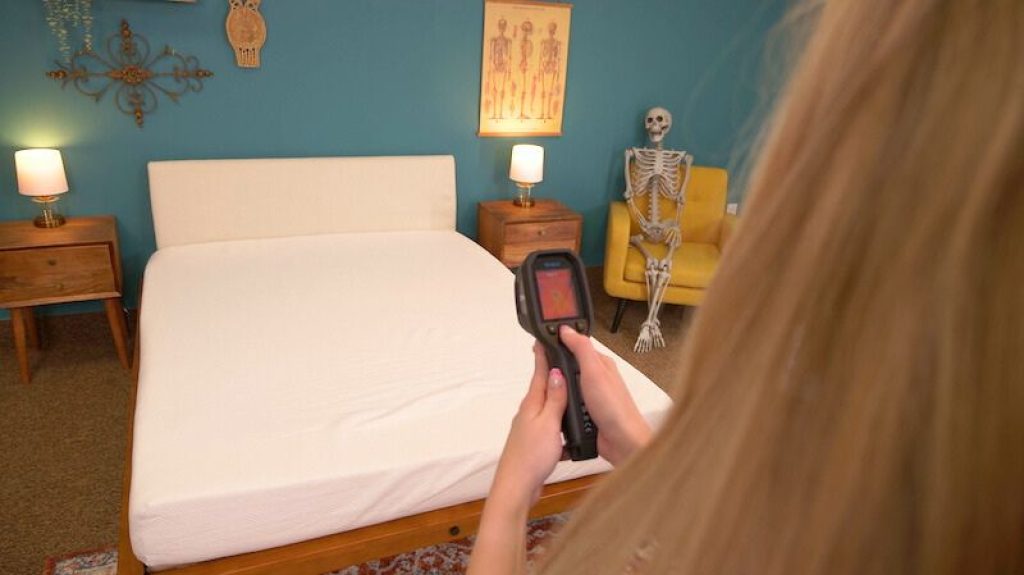
If you’re concerned about the bed still being too hot, you can get a mattress topper with cooling properties as well. I use a heat gun to see how well a mattress regulates temperature. I start by measuring its initial temperature, then its temperature after five minutes, and then again after another five minutes. I also take into consideration how the bed actually feels when I’m lying on it.
Motion Isolation
When experiencing back pain caused by conditions such as spinal stenosis, you may be especially tuned into your partner’s movements. If their twisting and turning is traveling to your side of the bed, it could cause you to move, which may aggravate the pain and pressure on your spine.
Therefore, if you co-sleep, find a mattress that prevents motion from traveling from one area of the bed to the other. We test motion isolation using a seismograph app to see how much movement is picked up when we roll around. Small waves tell us a mattress has good motion isolation, while higher waves mean you’ll likely feel your partner moving on the other side of the bed.
Sex
Those with spinal stenosis can still enjoy full and active sex lives. However, finding a bed that is good for your back pain and your sex life may be a little tricky. This is because those with spinal stenosis often benefit from memory foam beds that offer pressure-relieving contouring. However, the slow-moving nature of this type of bed is not necessarily conducive to sex.
Beds that are responsive and springy, such as latex and latex hybrids, tend to facilitate sex the best. Therefore, a memory foam or latex hybrid may be a consideration, as the top foam layer(s) can provide contouring and support while the coils provide a little more bounce for intimacy.
Browse the Best Mattresses for Sex.
Budget
When it’s time to buy a new bed, it’s important to look for quality materials and seek out brands that demonstrate that they understand this concept. A cheap memory foam bed, for example, will usually have poorer-quality foam that feels cozy at first but lacks durability.
Tell-tale signs of a cheap mattress are low-density foam, a lack of certifications, or integrated coil systems that do not offer tailored support.
We’ve compiled a list of high-quality affordable mattresses if you’re looking for a good deal.
What Causes Spinal Stenosis?
Spinal stenosis5 can occur when the spinal canal narrows, creating pressure on the spinal cord and nearby nerve roots. Multiple factors can cause spinal stenosis, such as age, arthritis, spine tumors, injuries, and Paget’s disease.
Spinal stenosis commonly affects two areas: the lumbar spine (lower back) and the cervical spine (neck).
- Lumbar (lower back) stenosis: This form of stenosis is when the narrowing of the spinal canal occurs in the lower back region, and according to Johns Hopkins Medicine6, spinal stenosis is most common in the lower back.
- Cervical (neck) stenosis: This condition happens when the spinal canal narrows in the neck. According to the University of Virginia School of Medicine7, along with pain, people with cervical stenosis may experience pain in one or both of their arms as well as an “electrical sensation” that shoots down their back when their head moves.
Spinal stenosis symptoms vary, and some patients don’t even know they have it. For the majority of people with this condition, they’ll experience one or more of the following1:
- Pain or cramping in the legs
- Back pain
- Numbness
- Tingling or weakness in the hands, legs, feet, or arms
- Difficulty walking or maintaining balance
- Neck pain
- Bladder or bowel problems
What Is the Best Sleeping Position for Spinal Stenosis?
Did you know that some sleeping positions can contribute to back pain? If you have spinal stenosis, you should be careful which position you choose to sleep in.
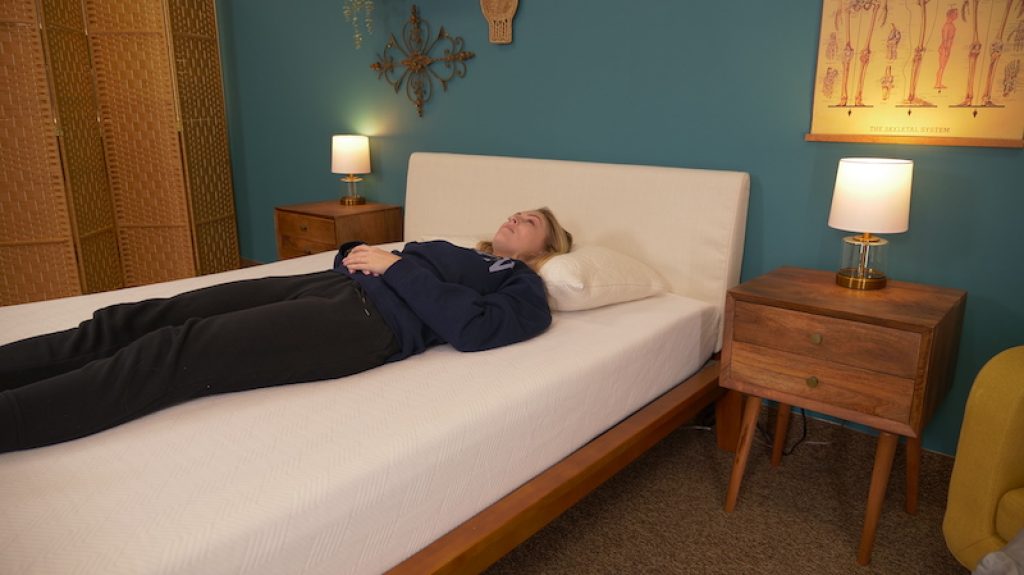
Back Sleeping
As mentioned, back sleeping puts the least pressure on your spine.2
To reduce pressure further, try to keep your upper body elevated. You can do this with either a wedge pillow or a mattress designed for an adjustable bed frame. You can also try maintaining a bend in your knees. Putting a pillow underneath them can help retain that bend, even when you’re asleep.
Browse the Best Mattresses for Back Sleepers.
Side Sleeping
Side sleeping, particularly in the fetal position, is also recommended for spinal stenosis.3 By drawing your knees up toward the chest, you relieve pressure on the nerve root.
Get more information on the Best Beds for Side Sleepers.
Combination Sleeping
For combination sleepers with spinal stenosis, you should stick to just rotating between your back and side. If you’re a combination sleeper and one of your go-to postures is stomach sleeping, try to avoid this posture so you don’t put added pressure on your lower back.
Discover the Best Mattresses for Combination Sleepers.
Stomach Sleeping
Those who prefer to sleep on their stomachs may exacerbate the pain from spinal stenosis. This is because sleeping on your stomach can cause your hips to sag too far into the bed, which can cause the lower back to curve and place the spine in poor alignment. Hours of strain on an already problematic area may prevent you from getting adequate rest and cause additional pain.
Check Out the Best Mattresses for Stomach Sleepers.
Tips for Better Sleeping With Spinal Stenosis
Along with getting a great mattress, you may also want to try some non-surgical or at-home treatments for spinal stenosis. Some doctors may recommend these remedies8 for pain relief since they’re safe and easy to do for most people.
- Physical therapy – Some exercise focus points might include spine motion, strengthening stomach and back muscles, swimming, and riding a bicycle.
- Acupuncture or spine and tissue manipulation – In acupuncture, thin needles are used on the body to help alleviate pain. The manipulation method involves a healthcare professional adjusting and massaging the spine and surrounding muscles.
- Pain Relievers – Over-the-counter pain relievers such as ibuprofen, aspirin, and acetaminophen can help reduce inflammation and pain associated with spinal stenosis.
- Walking Aids – Mobility aids, like canes and walkers, may give you more stability and relief as it helps to take some pressure off the back.
Best Mattress for Spinal Stenosis FAQs
How can I be comfortable with spinal stenosis?
Although there is no cure for spinal stenosis, there are steps you can implement to help relieve the pain. You should discuss options such as physical therapy or other medical solutions with your healthcare provider. Additionally, investing in a quality, pressure-relieving mattress and sleeping on your back or in the fetal position might also bring some comfort.
Can a bad mattress cause spinal stenosis?
No, mattresses don’t cause spinal stenosis. Spinal stenosis a degenerative disease typically associated with age.5 Although mattresses don’t cause spinal stenosis, a supportive, pressure-relieving bed may help ease some of the pain associated with it.
What mattress firmness is best for spinal stenosis?
People with spinal stenosis should benefit from a medium-firm mattress as research suggests9 this level of firmness is better for back pain issues. This firmness should offer good support for the spine, preventing the body from sinking into the bed and throwing the spine off alignment. In my experience, medium-firm beds also offer a bit of contouring to prevent pressure buildup in the lumbar area.
What kind of mattress do I need for spinal stenosis?
Based on my research (and the number of beds I’ve tested), memory foam, hybrid, and latex mattresses should work well for people with spinal stenosis. These beds can offer great pressure relief, responsiveness, and support for your back pain. Each one has its own advantages and disadvantages that you’ll also have to consider as well. For example, natural latex mattresses are eco-friendly, while memory foam excels at pressure relief and motion isolation.
What’s the best way to sleep if you have spinal stenosis?
Most people with spinal stenosis should find relief by sleeping in the fetal position, which is when you lie on your side and have your knees up near your abdomen. If this is uncomfortable for you, you can try sleeping on your back with your head and knees elevated.2
What activities should I avoid with spinal stenosis?
Although some exercises and stretches can provide relief, you should avoid certain physical activities10 like running, taking long walks, contact sports, jumping, climbing, deep back stretches, and biking on hilly or uneven terrain.
Is spinal stenosis a degenerative disc disease?
Spinal stenosis, which is the narrowing of the canal that houses the spinal nerves, can occur as a result of degenerative disc disease11. Degenerative disc disease, or DDD, is when the discs in your spine wear and tear, and this condition is often a result of aging.
How can I prevent spinal stenosis from getting worse?
To prevent spinal stenosis from getting worse, you should exercise regularly, practice good posture, avoid smoking, and follow guidance from your doctor8. For exercise, you may have difficulty getting started if you’re already in pain. Therefore, you can try low or no-impact exercises like walking and swimming. Practicing yoga and lifting weights are also excellent activities to keep your body strong.
To promote good posture, make sure you sit and stand without slouching, lift heavy objects carefully and with your legs (not your back), and sleep on a mattress that keeps your spine in proper alignment.
Quitting smoking is also helpful because nicotine inhibits blood flow12, which means fewer nutrients and less oxygen can reach your back for it to heal sooner.
Of course, following recommendations from your doctor is vital because they know your personal circumstances and limitations.
Can you recommend some good spinal stenosis exercises?
A 2018 study13 found that core stability exercises were more helpful for participants with lumbar spinal stenosis than regular exercise. You can do various exercises that could help open up the narrow passageways and
Additionally, there are other exercises14 that could help with spinal stenosis, including riding a bicycle, swimming, and taking Tai Chi classes that involve light and slow movements.
Anyone attempting any sort of new stretch or exercise should consult their doctor to ensure that the activities are safe and helpful for their body.
Final Word of Advice
Along with investing in a great bed that provides you with sufficient support and pressure relief to help mitigate spinal stenosis symptoms, I encourage you to consult with your primary care doctor, who can help guide you toward a more personalized treatment plan.
| Mattress | Best For | Price (Queen Size) | Review |
| Helix Midnight | Overall | $1,199 | Helix Midnight Mattress Review |
| Nolah Signature | Pressure Relief | $1,599 | Nolah Signature Mattress Review |
| The WinkBed | Hybrid | $1,799 | Winkbed Mattress Review |
| Saatva Rx | Back Pain | $3,295 | Saatva Rx Mattress Review |
| Bear Original | Memory Foam | $999 | Bear Mattress Review |
| Brooklyn Bedding Aurora Luxe | Cooling | $1,874 | Brooklyn Bedding Aurora Mattress Review |
| Titan Plus | Heavy People | $1,249 | Titan Plus Mattress Review |
| Plank Firm | Firm | $1,249 | Plank Firm Mattress Review |

Julia Forbes
Sleep Advisor Mattress Tester
About Author
Julia is a product tester at Sleep Advisor, specializing in testing out mattresses and sleep accessories – she’s in the right line of work, because she loves to sleep.
Stomach Sleeper
Education & Credentials
- Certified Sleep Science Coach
References:
- “Spinal stenosis”. Mayo Clinic. Last modified March 28, 2023.
- “Best Sleeping Positions for Pain”. Cleveland Clinic. 2023.
- Staehler MD, Richard. “Mattresses and Sleep Positions for Each Back Pain Diagnosis”. Spine Health. Last modified October 25, 2017.
- “Dehydration and Joint Pain: How Your Hydration is Affecting Joint Health”. Orthopedic Associates. Webpage accessed July 31, 2023.
- “Spinal Stenosis”. National Institute of Arthritis and Musculoskeletal and Skin Diseases. Last modified January 2020.
- “Lumbar Spinal Stenosis”. Johns Hopkins Medicine. Webpage accessed May 23, 2023.
- “Cervical Stenosis”. University of Virginia School of Medicine. Webpage accessed May 23, 2023.
- “Diagnosis of Spinal Stenosis”. National Institute of Arthritis and Musculoskeletal and Skin Diseases. Last modified January 2020.
- Caggiari, Gianfilippo., et. al. “What type of mattress should be chosen to avoid back pain and improve sleep quality? Review of the literature”. Journal of Orthopaedics and Traumatology. 2021.
- “What Activities Should Be Avoided With Spinal Stenosis?’. Premia Spine. 2022.
- “Degenerative disc disease”. Mayfield Clinic. Last modified January 2023.
- Benowitz, Neal L., Burbank, Andrea D. “Cardiovascular Toxicity of Nicotine: Implications for Electronic Cigarette Use”. National Library of Medicine. 2016.
- Mu, Wenzhi., et. al. “Comparison of two types of exercises in the treatment of lumbar spinal stenosis”. Pakistan Journal of Medical Sciences. 2018.
- Cooper MD, Grant. “Exercises for Lumbar Spinal Stenosis”. Last modified March 23, 2010.
